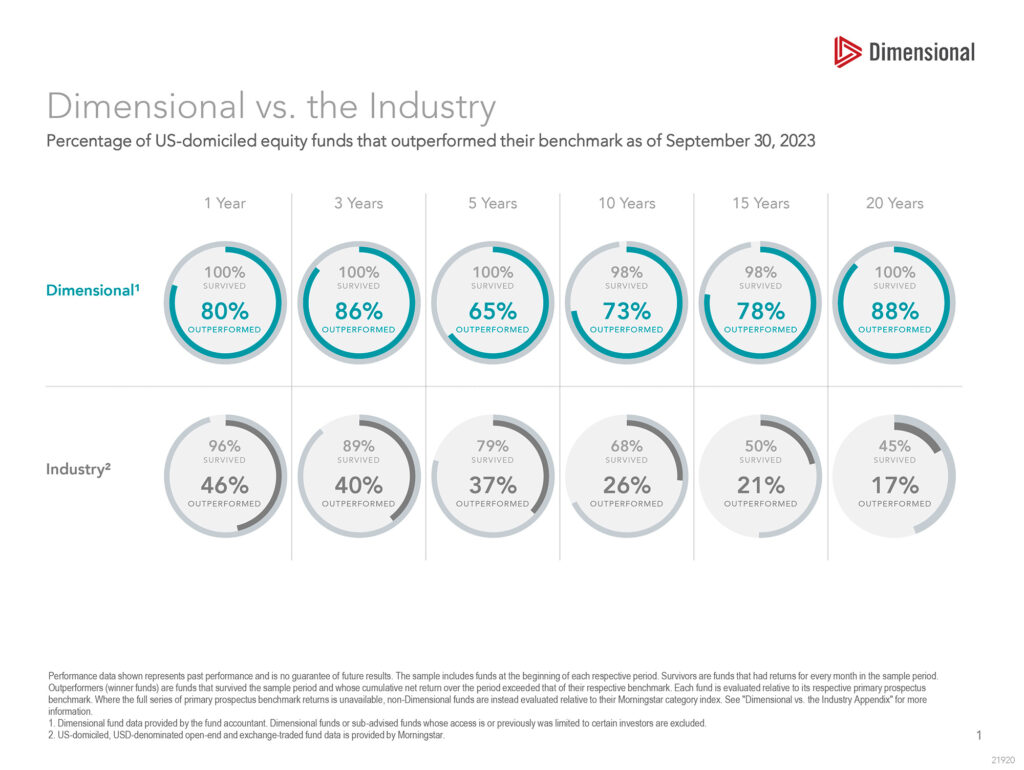Conventional wisdom says that active investment management provides the most value. But at JLFranklin Wealth Planning, we challenge that view by using evidence-backed investment strategies that demonstrate that more trades don’t translate into higher returns or more value.
In this post, we explore the differences between active and passive investment management, and why we believe our approach—which is neither of those—provides the best investment experience for our clients.
What Is Active Investment Management?
Active investment managers look for “mispriced” securities, or investments they believe are under- or overvalued. They seek to take advantage of these price inaccuracies to beat the market return through strategies like individual stock picking and timing the market. Not only does this approach involve higher costs and turnover rates, but history has also shown that only 17% of active equity managers both continued to operate and outperformed their benchmarks over the last 20 years, as shown in Figure 1, below.
Figure 1
What Is Passive Investment Management?
Passive investment management, sometimes called indexing, believes that all available information is already reflected in the price of a stock, and therefore there are no “mispriced” securities. Rather than beat a benchmark, passive investment managers seek to match the returns of a market index as closely as possible by replicating its holdings. Passive investing strategies are typically low cost and may be broadly diversified with low turnover rates.
However, since passive investment managers are forced to track an index created by a third-party provider (such as Russell or MSCI), even this strategy may encounter high trading costs. For example, an index manager must trade close to the dates that an index (such as the S&P 500) rebalances, and thus may pay a higher price around those dates.
The JLFranklin Approach to Investing
At JLFranklin Wealth Planning, we partner with Dimensional Fund Advisors and other fund companies to bring the best characteristics of active and passive management to our clients while keeping costs low, trading efficiency high, and diversification broad.
Just like with active management, we seek to beat our benchmarks, even after management fees. Unlike the poor survivorship of active managers, 88% of Dimensional’s equity funds have beaten their benchmarks over the last 20 years ending September 30, 2023, as shown in Figure 1 above. Drawing insights from financial science and Nobel Prize-winning academic research, Dimensional emphasizes areas of the market that are expected to produce high returns based on historical data.
Extremely Low Cost and Highly Efficient
Core equity funds, held when possible, are an all-encompassing strategy designed to provide cost-effective exposure to the stock market. We emphasize value stocks with a smaller market capitalization, lower prices relative to fundamental metrics such as book value, and higher profitability.
Our core funds are so efficient because they include the entire stock market instead of smaller market segments, such as large cap growth or small cap value stocks. This means as a stock grows from a small cap to a large cap, we can continue to hold the stock instead of selling it. This lower turnover leads to lower transaction costs, which can add up over time to produce higher returns.
Additionally, with this strategy, rebalancing can occur in a single fund, resulting in fewer forced trades, less frequent turnover, and lower transaction costs.
Broad Diversification
Some clients may look at their investment holdings, see fewer than 10 funds in their portfolio, and wonder if their portfolio is well diversified. We prioritize broad diversification, which is why each client’s stock fund holdings include thousands of individual stocks. With this level of exposure to the stock market, we do not need to trade weekly—or monthly—to chase stock market trends, though we do look at portfolios monthly, at a minimum, to confirm adherence to the chosen asset allocation and look for tax loss harvest opportunities.
Why Trading Less Can Mean More Value
We tailor our portfolio strategies to each client’s individual goals and risk tolerance. Our ability to use funds outside of the Dimensional universe means we can customize portfolios to fit our clients’ unique needs. When you have a long-term investment approach that you believe in, it doesn’t make sense to react to short-term market fluctuations and events. Doing so can cause more harm than good, as you are forced to time both your exit from the market and when to reinvest, missing out on the upswing in between.
Our philosophy is to trade only when there is a purpose for doing so, such as raising cash to fund lifestyle needs, or diversifying with the proceeds from company stock sales. Our value is shown in so many ways: Tax loss harvesting in response to large market drops, rebalancing when asset classes have veered away from their target bands, tax-efficiency using an asset location strategy, and proactive financial planning to help our clients achieve their long-term goals are just a few.
To learn more about our investment philosophy, or to schedule a consultation to discuss your specific situation, start here.






